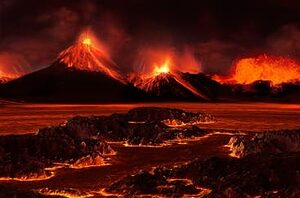Some 252 million years ago, 96 percent of marine species and 70 percent of life on land became extinct following a yet unconfirmed series of cataclysmic events. Around this time, billions and billions of organisms were killed and life on Earth faced its most dire moments. This is known as the end-Permian extinction, and many theories have been devised trying to explain what triggered this massive die-off. A new geological analysis by scientists at MIT provides a refined time frame during which the extinction took place. Apparently, the extinction happened much faster than previously believed. Moreover, armed with this information, scientists may now test some of the leading hypotheses that try to explain the extinction.

Sam Bowring, the Robert R. Shrock Professor of Earth and Planetary Sciences at MIT, and team first traveled to Meishan, China in 2006. Here, geologists from all over the world have made various trips since the area holds invaluable clues in its layers of sedimentary rock. On section of rock, in particular, is thought to delineate the end of the Permian, and the beginning of the Triassic, based on evidence such as the number of fossils found in surrounding rock layers.
A massive die-off
Their first sample analysis suggested that the end-Permian likely lasted less than 200,000 years, as reported in 2011. Using a more refined technique, Bowring now says that they’ve reached a more accurate time-frame. Rock samples collected from five volcanic ash beds at the Permian-Triassic boundary were pulverized, so that tiny zircon crystals containing a mix of uranium and lead could be gathered. The researchers then separated the the lead from the uranium and measured the ratios of both isotopes to determine the age of each rock sample.
The new measurements reveal a more precise age model for the end-Permian extinction. It likely lasted for 60,000 years — with an uncertainty of 48,000 years . In geological terms, this is nothing more than the blink of an eye. Apparently, this was too fast for most life on Earth to adapt. The samples also confirmed what was known for a while: the extinction was preceded by a sharp increase in carbon dioxide in the oceans.
What’s the killer?
Some 10,000 years before the die-off, a massive and sudden influx of carbon dioxide was released into the atmosphere, poisoning life on land and acidifying the world’s oceans. Most of the carbon was absorbed by the oceans which act like huge heat-sinks, increasing sea temperatures by as much as 10 degrees Celsius – too hot for anything to survive. It took life on Earth ten million years to recover from this event. It’s important to note that ocean acidification is happening today at a growing rate due to global warming and man-made carbon emissions.
[ANOTHER THEORY] Permian extinction caused by ‘lemon juice’ acid rain [?]
What triggered this dramatic cataclysm? The leading theory is that it was caused by long-lasting volcanic eruptions from the Siberian Traps, a region of Russia whose steplike hills are a result of repeated eruptions of magma. The eruption released volatile chemicals, including carbon dioxide, into the atmosphere and oceans, covering an estimated five million cubic kilometers.
The new refined timeline adds weight to this theory, but it’s still too early to tell for sure. Next, Bowring plan to determine an equally precise timeline for the Siberian Traps eruptions. If the eruptions and the eruption timeline overlap, than scientists can infer with a degree of confidence that indeed that’s what caused the extinction.
“We’ve refined our approach, and now we have higher accuracy and precision,” Bowring says. “You can think of it as slowly spiraling in toward the truth.”
The report was published in the Proceedings of the National Academy of Science.






